Business Strategy for Tesco Plc: Analysis and Evaluation
VerifiedAdded on 2023/06/08
|15
|4502
|299
AI Summary
This report provides an analysis and evaluation of the business strategy of Tesco Plc, including PESTLE and SWOT analysis, Porter's Five Forces model, identification of competitive advantage, and valid strategies and tactical objectives to achieve overall strategic objectives.
Contribute Materials
Your contribution can guide someone’s learning journey. Share your
documents today.
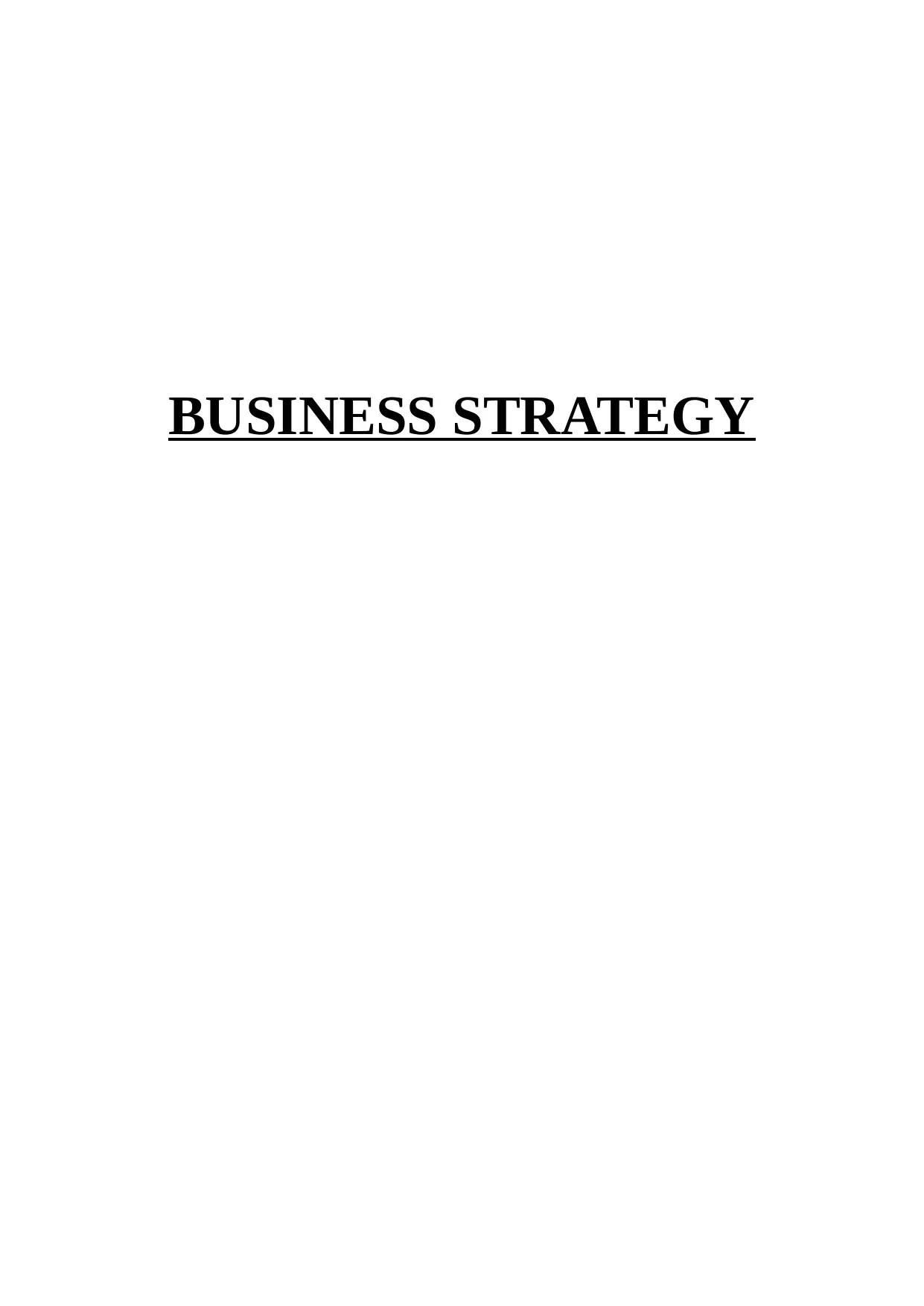
BUSINESS STRATEGY
Secure Best Marks with AI Grader
Need help grading? Try our AI Grader for instant feedback on your assignments.
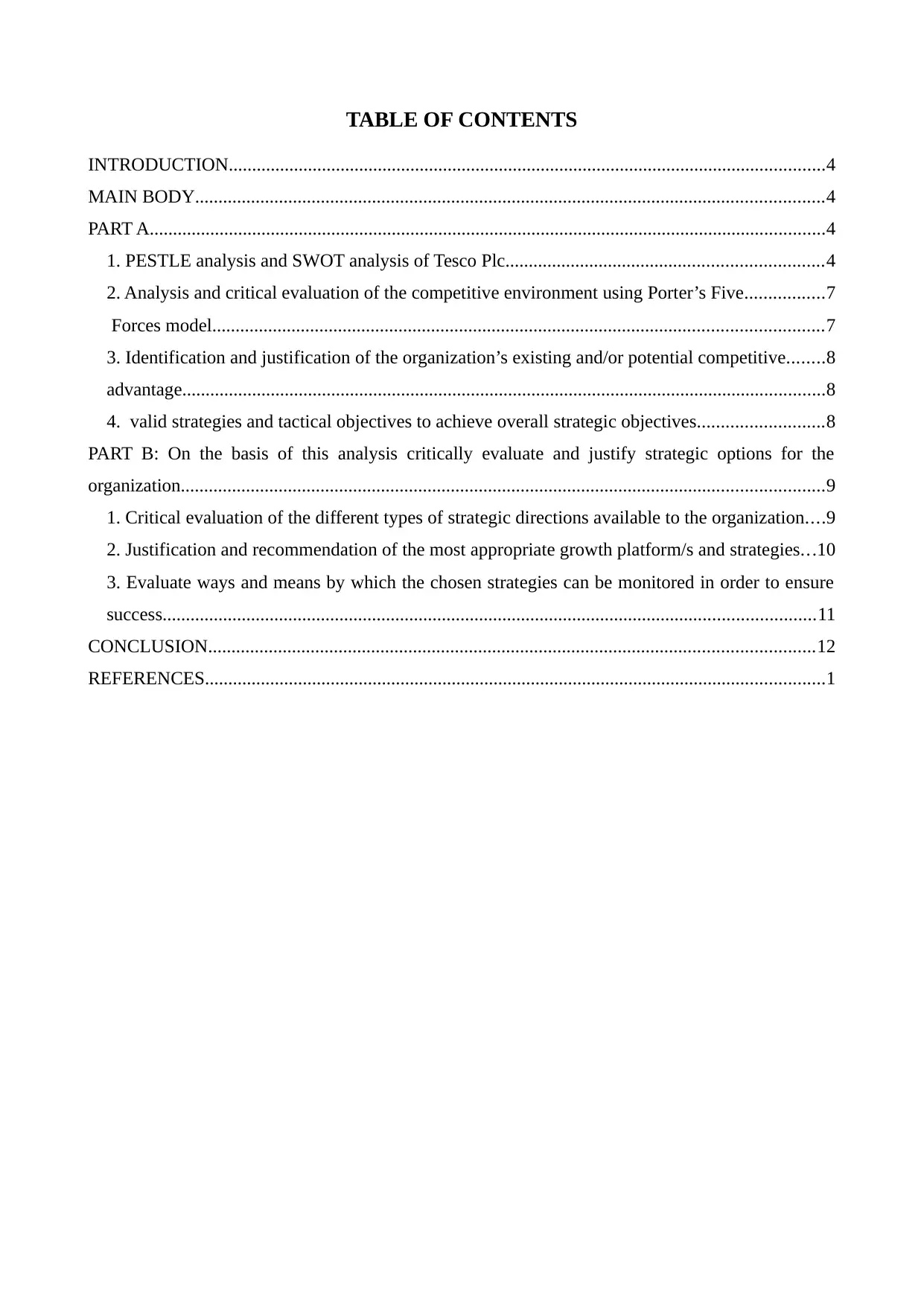
TABLE OF CONTENTS
INTRODUCTION................................................................................................................................4
MAIN BODY.......................................................................................................................................4
PART A.................................................................................................................................................4
1. PESTLE analysis and SWOT analysis of Tesco Plc....................................................................4
2. Analysis and critical evaluation of the competitive environment using Porter’s Five.................7
Forces model...................................................................................................................................7
3. Identification and justification of the organization’s existing and/or potential competitive........8
advantage..........................................................................................................................................8
4. valid strategies and tactical objectives to achieve overall strategic objectives...........................8
PART B: On the basis of this analysis critically evaluate and justify strategic options for the
organization..........................................................................................................................................9
1. Critical evaluation of the different types of strategic directions available to the organization....9
2. Justification and recommendation of the most appropriate growth platform/s and strategies...10
3. Evaluate ways and means by which the chosen strategies can be monitored in order to ensure
success............................................................................................................................................11
CONCLUSION..................................................................................................................................12
REFERENCES.....................................................................................................................................1
INTRODUCTION................................................................................................................................4
MAIN BODY.......................................................................................................................................4
PART A.................................................................................................................................................4
1. PESTLE analysis and SWOT analysis of Tesco Plc....................................................................4
2. Analysis and critical evaluation of the competitive environment using Porter’s Five.................7
Forces model...................................................................................................................................7
3. Identification and justification of the organization’s existing and/or potential competitive........8
advantage..........................................................................................................................................8
4. valid strategies and tactical objectives to achieve overall strategic objectives...........................8
PART B: On the basis of this analysis critically evaluate and justify strategic options for the
organization..........................................................................................................................................9
1. Critical evaluation of the different types of strategic directions available to the organization....9
2. Justification and recommendation of the most appropriate growth platform/s and strategies...10
3. Evaluate ways and means by which the chosen strategies can be monitored in order to ensure
success............................................................................................................................................11
CONCLUSION..................................................................................................................................12
REFERENCES.....................................................................................................................................1

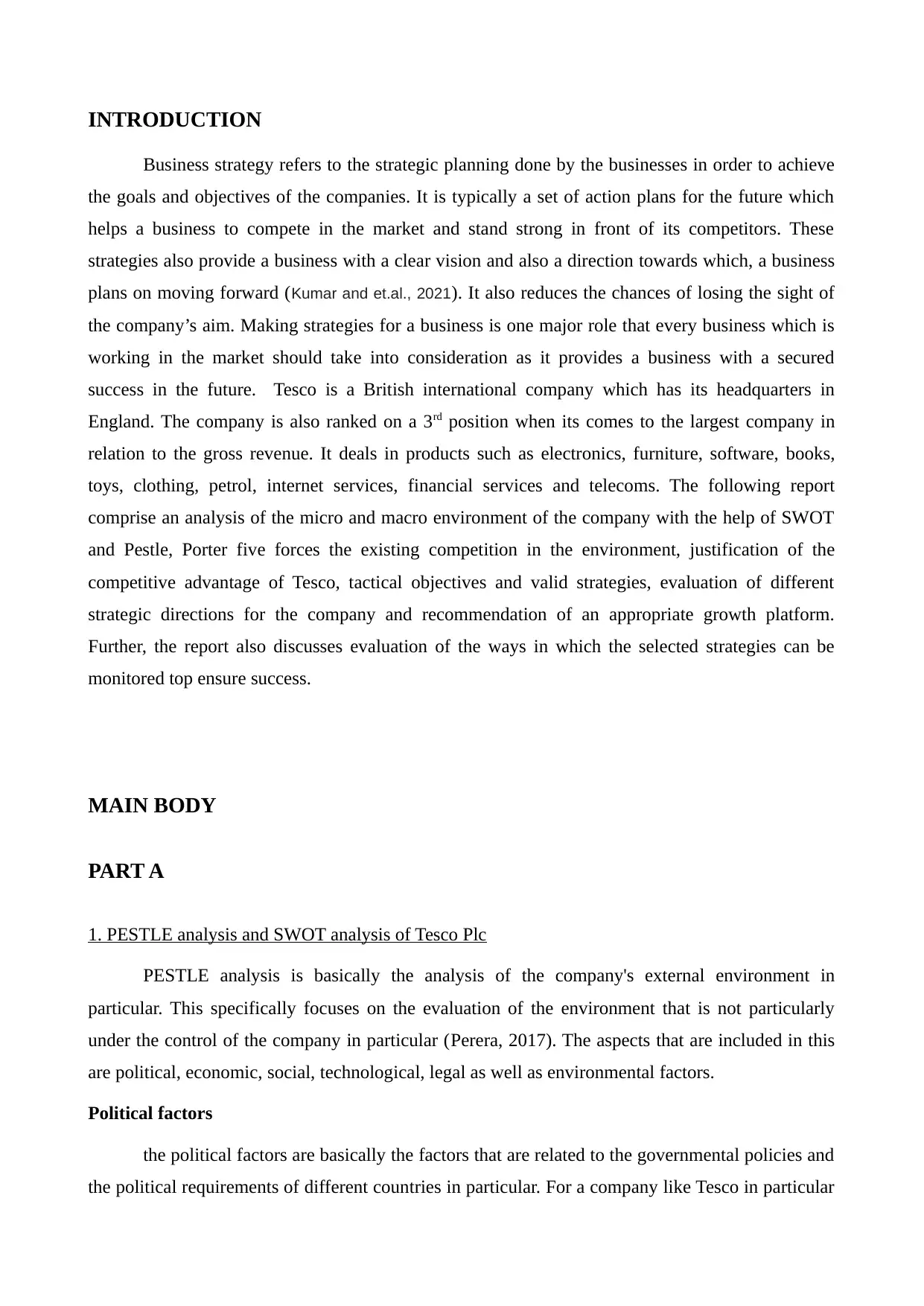
INTRODUCTION
Business strategy refers to the strategic planning done by the businesses in order to achieve
the goals and objectives of the companies. It is typically a set of action plans for the future which
helps a business to compete in the market and stand strong in front of its competitors. These
strategies also provide a business with a clear vision and also a direction towards which, a business
plans on moving forward (Kumar and et.al., 2021). It also reduces the chances of losing the sight of
the company’s aim. Making strategies for a business is one major role that every business which is
working in the market should take into consideration as it provides a business with a secured
success in the future. Tesco is a British international company which has its headquarters in
England. The company is also ranked on a 3rd position when its comes to the largest company in
relation to the gross revenue. It deals in products such as electronics, furniture, software, books,
toys, clothing, petrol, internet services, financial services and telecoms. The following report
comprise an analysis of the micro and macro environment of the company with the help of SWOT
and Pestle, Porter five forces the existing competition in the environment, justification of the
competitive advantage of Tesco, tactical objectives and valid strategies, evaluation of different
strategic directions for the company and recommendation of an appropriate growth platform.
Further, the report also discusses evaluation of the ways in which the selected strategies can be
monitored top ensure success.
MAIN BODY
PART A
1. PESTLE analysis and SWOT analysis of Tesco Plc
PESTLE analysis is basically the analysis of the company's external environment in
particular. This specifically focuses on the evaluation of the environment that is not particularly
under the control of the company in particular (Perera, 2017). The aspects that are included in this
are political, economic, social, technological, legal as well as environmental factors.
Political factors
the political factors are basically the factors that are related to the governmental policies and
the political requirements of different countries in particular. For a company like Tesco in particular
Business strategy refers to the strategic planning done by the businesses in order to achieve
the goals and objectives of the companies. It is typically a set of action plans for the future which
helps a business to compete in the market and stand strong in front of its competitors. These
strategies also provide a business with a clear vision and also a direction towards which, a business
plans on moving forward (Kumar and et.al., 2021). It also reduces the chances of losing the sight of
the company’s aim. Making strategies for a business is one major role that every business which is
working in the market should take into consideration as it provides a business with a secured
success in the future. Tesco is a British international company which has its headquarters in
England. The company is also ranked on a 3rd position when its comes to the largest company in
relation to the gross revenue. It deals in products such as electronics, furniture, software, books,
toys, clothing, petrol, internet services, financial services and telecoms. The following report
comprise an analysis of the micro and macro environment of the company with the help of SWOT
and Pestle, Porter five forces the existing competition in the environment, justification of the
competitive advantage of Tesco, tactical objectives and valid strategies, evaluation of different
strategic directions for the company and recommendation of an appropriate growth platform.
Further, the report also discusses evaluation of the ways in which the selected strategies can be
monitored top ensure success.
MAIN BODY
PART A
1. PESTLE analysis and SWOT analysis of Tesco Plc
PESTLE analysis is basically the analysis of the company's external environment in
particular. This specifically focuses on the evaluation of the environment that is not particularly
under the control of the company in particular (Perera, 2017). The aspects that are included in this
are political, economic, social, technological, legal as well as environmental factors.
Political factors
the political factors are basically the factors that are related to the governmental policies and
the political requirements of different countries in particular. For a company like Tesco in particular
Secure Best Marks with AI Grader
Need help grading? Try our AI Grader for instant feedback on your assignments.
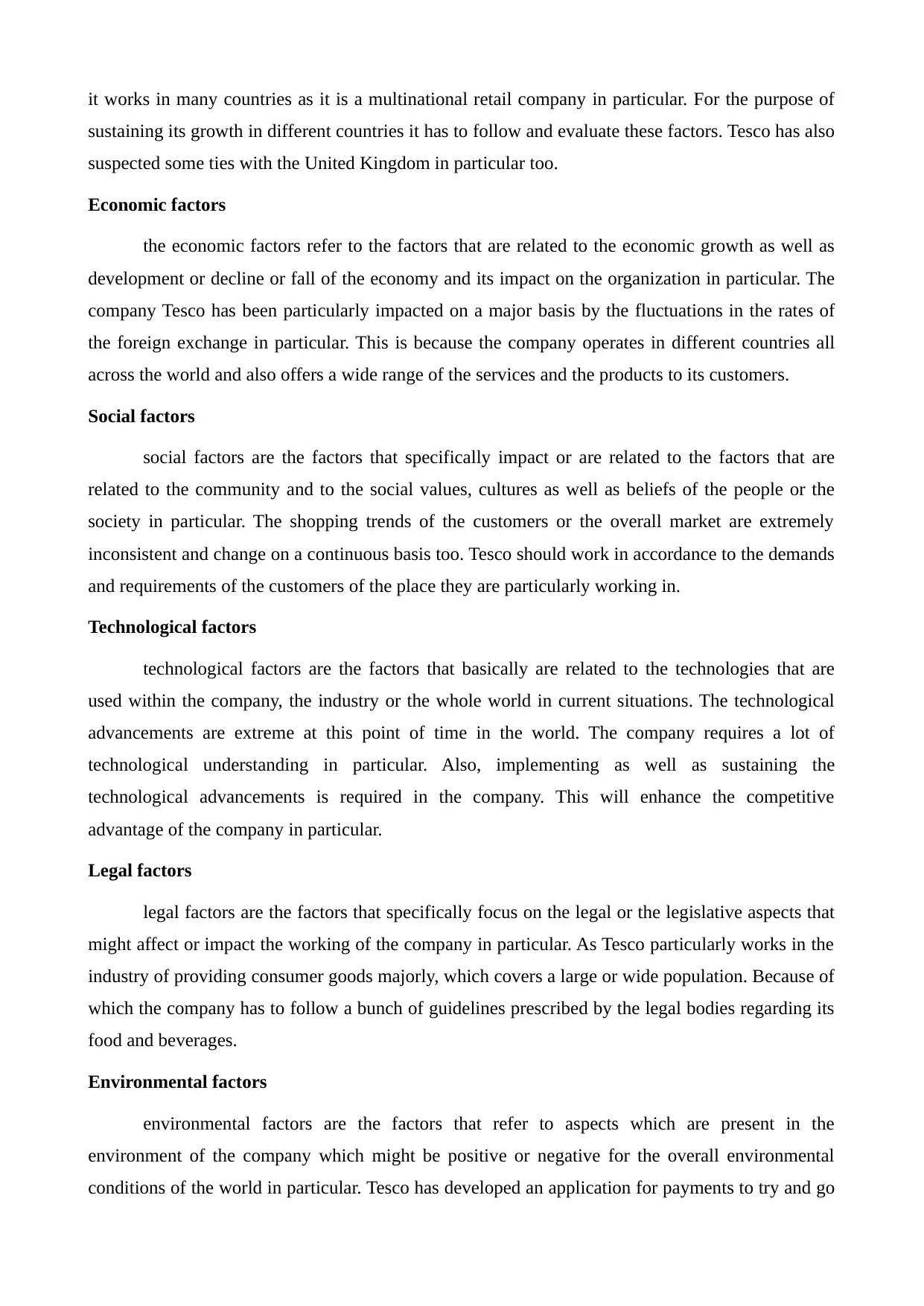
it works in many countries as it is a multinational retail company in particular. For the purpose of
sustaining its growth in different countries it has to follow and evaluate these factors. Tesco has also
suspected some ties with the United Kingdom in particular too.
Economic factors
the economic factors refer to the factors that are related to the economic growth as well as
development or decline or fall of the economy and its impact on the organization in particular. The
company Tesco has been particularly impacted on a major basis by the fluctuations in the rates of
the foreign exchange in particular. This is because the company operates in different countries all
across the world and also offers a wide range of the services and the products to its customers.
Social factors
social factors are the factors that specifically impact or are related to the factors that are
related to the community and to the social values, cultures as well as beliefs of the people or the
society in particular. The shopping trends of the customers or the overall market are extremely
inconsistent and change on a continuous basis too. Tesco should work in accordance to the demands
and requirements of the customers of the place they are particularly working in.
Technological factors
technological factors are the factors that basically are related to the technologies that are
used within the company, the industry or the whole world in current situations. The technological
advancements are extreme at this point of time in the world. The company requires a lot of
technological understanding in particular. Also, implementing as well as sustaining the
technological advancements is required in the company. This will enhance the competitive
advantage of the company in particular.
Legal factors
legal factors are the factors that specifically focus on the legal or the legislative aspects that
might affect or impact the working of the company in particular. As Tesco particularly works in the
industry of providing consumer goods majorly, which covers a large or wide population. Because of
which the company has to follow a bunch of guidelines prescribed by the legal bodies regarding its
food and beverages.
Environmental factors
environmental factors are the factors that refer to aspects which are present in the
environment of the company which might be positive or negative for the overall environmental
conditions of the world in particular. Tesco has developed an application for payments to try and go
sustaining its growth in different countries it has to follow and evaluate these factors. Tesco has also
suspected some ties with the United Kingdom in particular too.
Economic factors
the economic factors refer to the factors that are related to the economic growth as well as
development or decline or fall of the economy and its impact on the organization in particular. The
company Tesco has been particularly impacted on a major basis by the fluctuations in the rates of
the foreign exchange in particular. This is because the company operates in different countries all
across the world and also offers a wide range of the services and the products to its customers.
Social factors
social factors are the factors that specifically impact or are related to the factors that are
related to the community and to the social values, cultures as well as beliefs of the people or the
society in particular. The shopping trends of the customers or the overall market are extremely
inconsistent and change on a continuous basis too. Tesco should work in accordance to the demands
and requirements of the customers of the place they are particularly working in.
Technological factors
technological factors are the factors that basically are related to the technologies that are
used within the company, the industry or the whole world in current situations. The technological
advancements are extreme at this point of time in the world. The company requires a lot of
technological understanding in particular. Also, implementing as well as sustaining the
technological advancements is required in the company. This will enhance the competitive
advantage of the company in particular.
Legal factors
legal factors are the factors that specifically focus on the legal or the legislative aspects that
might affect or impact the working of the company in particular. As Tesco particularly works in the
industry of providing consumer goods majorly, which covers a large or wide population. Because of
which the company has to follow a bunch of guidelines prescribed by the legal bodies regarding its
food and beverages.
Environmental factors
environmental factors are the factors that refer to aspects which are present in the
environment of the company which might be positive or negative for the overall environmental
conditions of the world in particular. Tesco has developed an application for payments to try and go
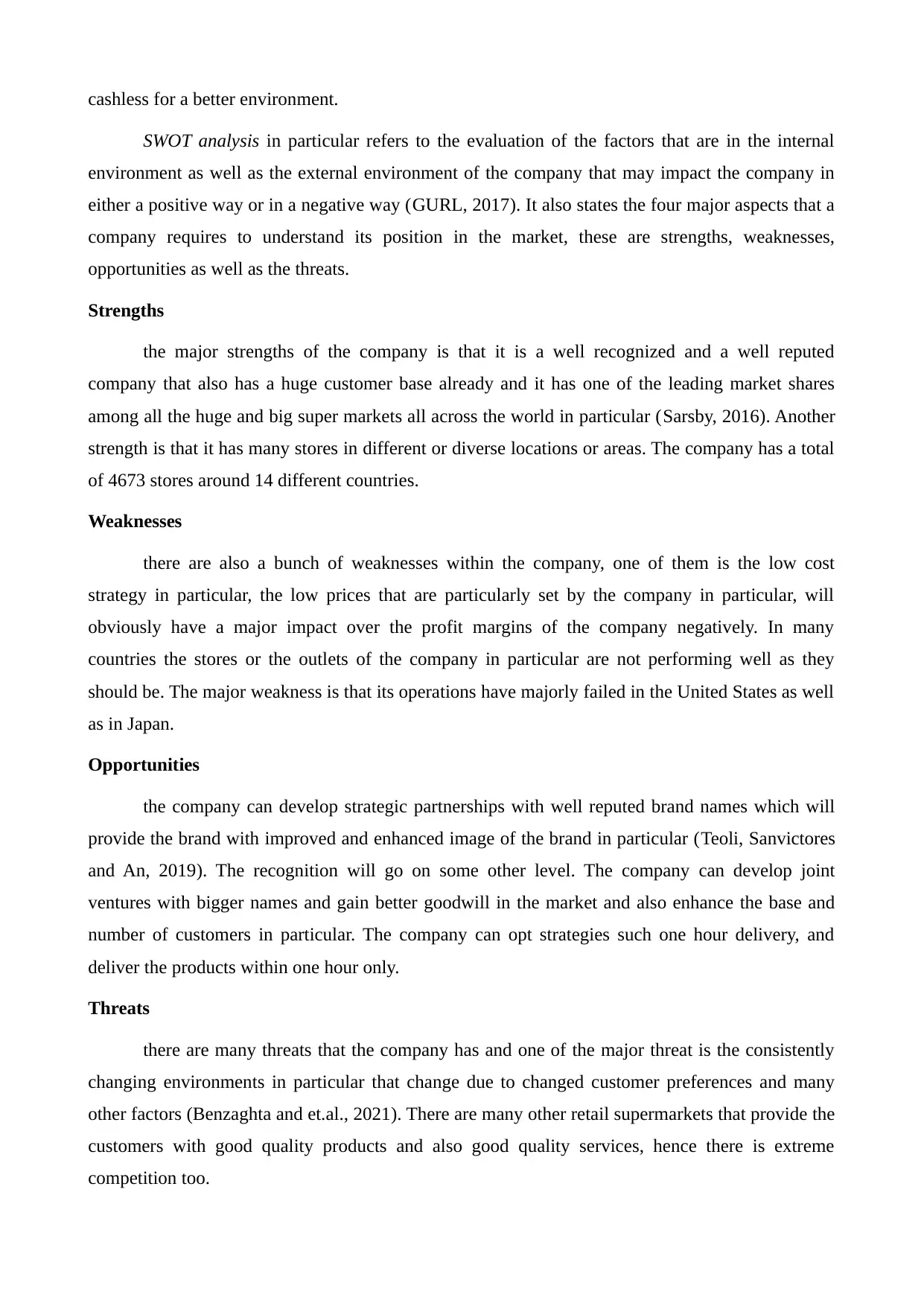
cashless for a better environment.
SWOT analysis in particular refers to the evaluation of the factors that are in the internal
environment as well as the external environment of the company that may impact the company in
either a positive way or in a negative way (GURL, 2017). It also states the four major aspects that a
company requires to understand its position in the market, these are strengths, weaknesses,
opportunities as well as the threats.
Strengths
the major strengths of the company is that it is a well recognized and a well reputed
company that also has a huge customer base already and it has one of the leading market shares
among all the huge and big super markets all across the world in particular (Sarsby, 2016). Another
strength is that it has many stores in different or diverse locations or areas. The company has a total
of 4673 stores around 14 different countries.
Weaknesses
there are also a bunch of weaknesses within the company, one of them is the low cost
strategy in particular, the low prices that are particularly set by the company in particular, will
obviously have a major impact over the profit margins of the company negatively. In many
countries the stores or the outlets of the company in particular are not performing well as they
should be. The major weakness is that its operations have majorly failed in the United States as well
as in Japan.
Opportunities
the company can develop strategic partnerships with well reputed brand names which will
provide the brand with improved and enhanced image of the brand in particular (Teoli, Sanvictores
and An, 2019). The recognition will go on some other level. The company can develop joint
ventures with bigger names and gain better goodwill in the market and also enhance the base and
number of customers in particular. The company can opt strategies such one hour delivery, and
deliver the products within one hour only.
Threats
there are many threats that the company has and one of the major threat is the consistently
changing environments in particular that change due to changed customer preferences and many
other factors (Benzaghta and et.al., 2021). There are many other retail supermarkets that provide the
customers with good quality products and also good quality services, hence there is extreme
competition too.
SWOT analysis in particular refers to the evaluation of the factors that are in the internal
environment as well as the external environment of the company that may impact the company in
either a positive way or in a negative way (GURL, 2017). It also states the four major aspects that a
company requires to understand its position in the market, these are strengths, weaknesses,
opportunities as well as the threats.
Strengths
the major strengths of the company is that it is a well recognized and a well reputed
company that also has a huge customer base already and it has one of the leading market shares
among all the huge and big super markets all across the world in particular (Sarsby, 2016). Another
strength is that it has many stores in different or diverse locations or areas. The company has a total
of 4673 stores around 14 different countries.
Weaknesses
there are also a bunch of weaknesses within the company, one of them is the low cost
strategy in particular, the low prices that are particularly set by the company in particular, will
obviously have a major impact over the profit margins of the company negatively. In many
countries the stores or the outlets of the company in particular are not performing well as they
should be. The major weakness is that its operations have majorly failed in the United States as well
as in Japan.
Opportunities
the company can develop strategic partnerships with well reputed brand names which will
provide the brand with improved and enhanced image of the brand in particular (Teoli, Sanvictores
and An, 2019). The recognition will go on some other level. The company can develop joint
ventures with bigger names and gain better goodwill in the market and also enhance the base and
number of customers in particular. The company can opt strategies such one hour delivery, and
deliver the products within one hour only.
Threats
there are many threats that the company has and one of the major threat is the consistently
changing environments in particular that change due to changed customer preferences and many
other factors (Benzaghta and et.al., 2021). There are many other retail supermarkets that provide the
customers with good quality products and also good quality services, hence there is extreme
competition too.
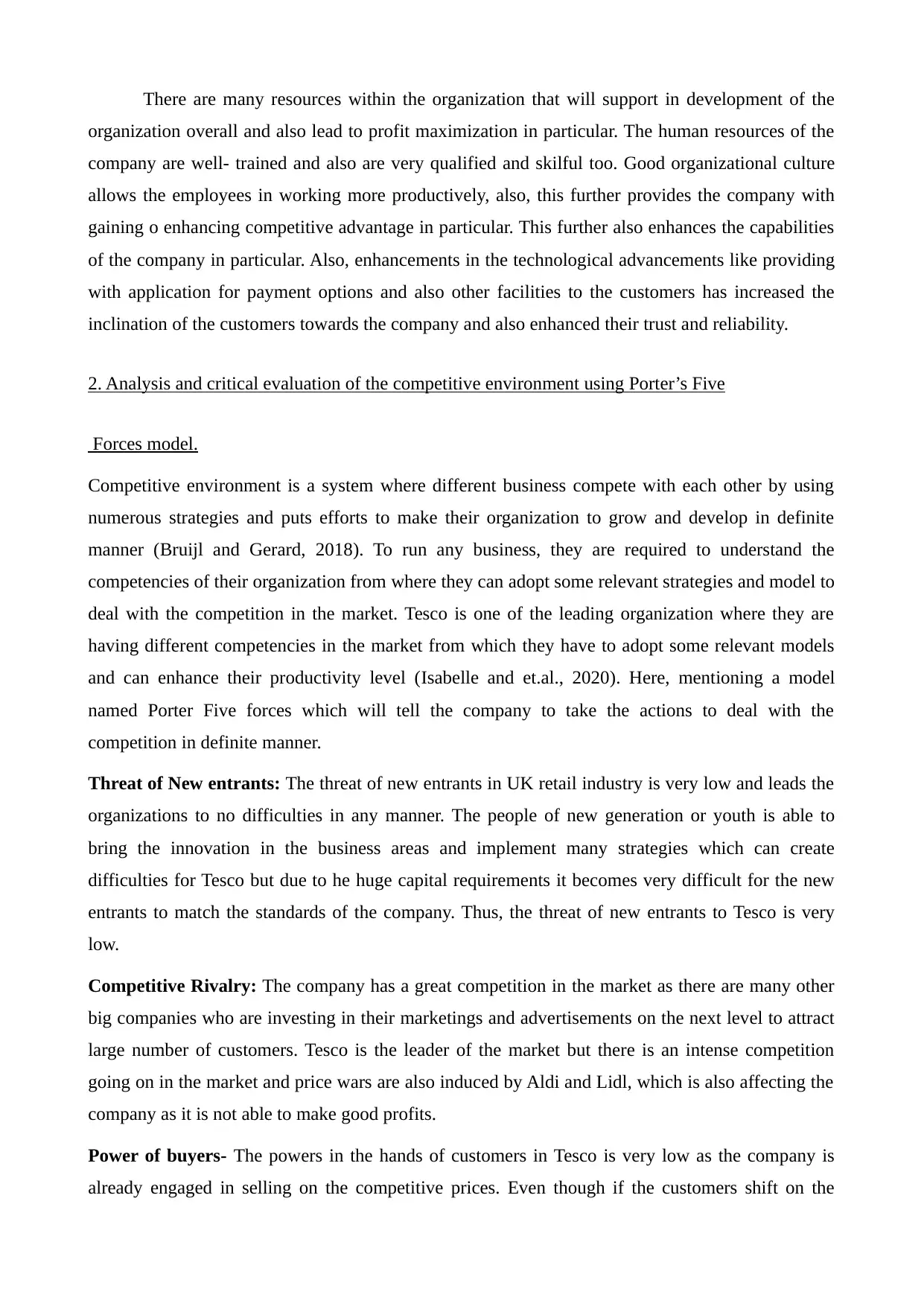
There are many resources within the organization that will support in development of the
organization overall and also lead to profit maximization in particular. The human resources of the
company are well- trained and also are very qualified and skilful too. Good organizational culture
allows the employees in working more productively, also, this further provides the company with
gaining o enhancing competitive advantage in particular. This further also enhances the capabilities
of the company in particular. Also, enhancements in the technological advancements like providing
with application for payment options and also other facilities to the customers has increased the
inclination of the customers towards the company and also enhanced their trust and reliability.
2. Analysis and critical evaluation of the competitive environment using Porter’s Five
Forces model.
Competitive environment is a system where different business compete with each other by using
numerous strategies and puts efforts to make their organization to grow and develop in definite
manner (Bruijl and Gerard, 2018). To run any business, they are required to understand the
competencies of their organization from where they can adopt some relevant strategies and model to
deal with the competition in the market. Tesco is one of the leading organization where they are
having different competencies in the market from which they have to adopt some relevant models
and can enhance their productivity level (Isabelle and et.al., 2020). Here, mentioning a model
named Porter Five forces which will tell the company to take the actions to deal with the
competition in definite manner.
Threat of New entrants: The threat of new entrants in UK retail industry is very low and leads the
organizations to no difficulties in any manner. The people of new generation or youth is able to
bring the innovation in the business areas and implement many strategies which can create
difficulties for Tesco but due to he huge capital requirements it becomes very difficult for the new
entrants to match the standards of the company. Thus, the threat of new entrants to Tesco is very
low.
Competitive Rivalry: The company has a great competition in the market as there are many other
big companies who are investing in their marketings and advertisements on the next level to attract
large number of customers. Tesco is the leader of the market but there is an intense competition
going on in the market and price wars are also induced by Aldi and Lidl, which is also affecting the
company as it is not able to make good profits.
Power of buyers- The powers in the hands of customers in Tesco is very low as the company is
already engaged in selling on the competitive prices. Even though if the customers shift on the
organization overall and also lead to profit maximization in particular. The human resources of the
company are well- trained and also are very qualified and skilful too. Good organizational culture
allows the employees in working more productively, also, this further provides the company with
gaining o enhancing competitive advantage in particular. This further also enhances the capabilities
of the company in particular. Also, enhancements in the technological advancements like providing
with application for payment options and also other facilities to the customers has increased the
inclination of the customers towards the company and also enhanced their trust and reliability.
2. Analysis and critical evaluation of the competitive environment using Porter’s Five
Forces model.
Competitive environment is a system where different business compete with each other by using
numerous strategies and puts efforts to make their organization to grow and develop in definite
manner (Bruijl and Gerard, 2018). To run any business, they are required to understand the
competencies of their organization from where they can adopt some relevant strategies and model to
deal with the competition in the market. Tesco is one of the leading organization where they are
having different competencies in the market from which they have to adopt some relevant models
and can enhance their productivity level (Isabelle and et.al., 2020). Here, mentioning a model
named Porter Five forces which will tell the company to take the actions to deal with the
competition in definite manner.
Threat of New entrants: The threat of new entrants in UK retail industry is very low and leads the
organizations to no difficulties in any manner. The people of new generation or youth is able to
bring the innovation in the business areas and implement many strategies which can create
difficulties for Tesco but due to he huge capital requirements it becomes very difficult for the new
entrants to match the standards of the company. Thus, the threat of new entrants to Tesco is very
low.
Competitive Rivalry: The company has a great competition in the market as there are many other
big companies who are investing in their marketings and advertisements on the next level to attract
large number of customers. Tesco is the leader of the market but there is an intense competition
going on in the market and price wars are also induced by Aldi and Lidl, which is also affecting the
company as it is not able to make good profits.
Power of buyers- The powers in the hands of customers in Tesco is very low as the company is
already engaged in selling on the competitive prices. Even though if the customers shift on the
Paraphrase This Document
Need a fresh take? Get an instant paraphrase of this document with our AI Paraphraser
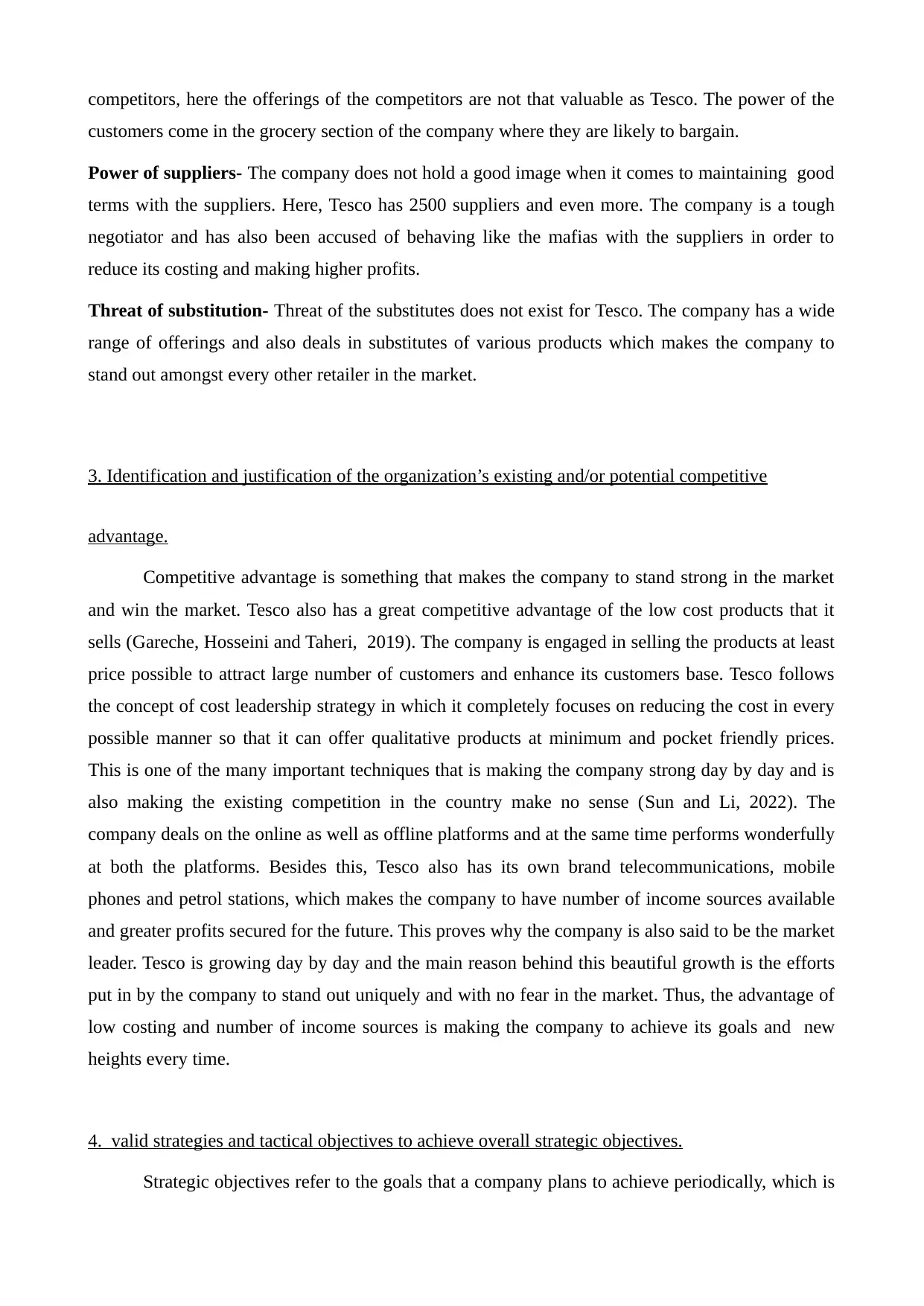
competitors, here the offerings of the competitors are not that valuable as Tesco. The power of the
customers come in the grocery section of the company where they are likely to bargain.
Power of suppliers- The company does not hold a good image when it comes to maintaining good
terms with the suppliers. Here, Tesco has 2500 suppliers and even more. The company is a tough
negotiator and has also been accused of behaving like the mafias with the suppliers in order to
reduce its costing and making higher profits.
Threat of substitution- Threat of the substitutes does not exist for Tesco. The company has a wide
range of offerings and also deals in substitutes of various products which makes the company to
stand out amongst every other retailer in the market.
3. Identification and justification of the organization’s existing and/or potential competitive
advantage.
Competitive advantage is something that makes the company to stand strong in the market
and win the market. Tesco also has a great competitive advantage of the low cost products that it
sells (Gareche, Hosseini and Taheri, 2019). The company is engaged in selling the products at least
price possible to attract large number of customers and enhance its customers base. Tesco follows
the concept of cost leadership strategy in which it completely focuses on reducing the cost in every
possible manner so that it can offer qualitative products at minimum and pocket friendly prices.
This is one of the many important techniques that is making the company strong day by day and is
also making the existing competition in the country make no sense (Sun and Li, 2022). The
company deals on the online as well as offline platforms and at the same time performs wonderfully
at both the platforms. Besides this, Tesco also has its own brand telecommunications, mobile
phones and petrol stations, which makes the company to have number of income sources available
and greater profits secured for the future. This proves why the company is also said to be the market
leader. Tesco is growing day by day and the main reason behind this beautiful growth is the efforts
put in by the company to stand out uniquely and with no fear in the market. Thus, the advantage of
low costing and number of income sources is making the company to achieve its goals and new
heights every time.
4. valid strategies and tactical objectives to achieve overall strategic objectives.
Strategic objectives refer to the goals that a company plans to achieve periodically, which is
customers come in the grocery section of the company where they are likely to bargain.
Power of suppliers- The company does not hold a good image when it comes to maintaining good
terms with the suppliers. Here, Tesco has 2500 suppliers and even more. The company is a tough
negotiator and has also been accused of behaving like the mafias with the suppliers in order to
reduce its costing and making higher profits.
Threat of substitution- Threat of the substitutes does not exist for Tesco. The company has a wide
range of offerings and also deals in substitutes of various products which makes the company to
stand out amongst every other retailer in the market.
3. Identification and justification of the organization’s existing and/or potential competitive
advantage.
Competitive advantage is something that makes the company to stand strong in the market
and win the market. Tesco also has a great competitive advantage of the low cost products that it
sells (Gareche, Hosseini and Taheri, 2019). The company is engaged in selling the products at least
price possible to attract large number of customers and enhance its customers base. Tesco follows
the concept of cost leadership strategy in which it completely focuses on reducing the cost in every
possible manner so that it can offer qualitative products at minimum and pocket friendly prices.
This is one of the many important techniques that is making the company strong day by day and is
also making the existing competition in the country make no sense (Sun and Li, 2022). The
company deals on the online as well as offline platforms and at the same time performs wonderfully
at both the platforms. Besides this, Tesco also has its own brand telecommunications, mobile
phones and petrol stations, which makes the company to have number of income sources available
and greater profits secured for the future. This proves why the company is also said to be the market
leader. Tesco is growing day by day and the main reason behind this beautiful growth is the efforts
put in by the company to stand out uniquely and with no fear in the market. Thus, the advantage of
low costing and number of income sources is making the company to achieve its goals and new
heights every time.
4. valid strategies and tactical objectives to achieve overall strategic objectives.
Strategic objectives refer to the goals that a company plans to achieve periodically, which is

typically the time period of 3-5 years. Whereas, tactical objectives refer to the goals which are made
for the short period, most likely for 3-12 months (Khalifa, 2021). These goals should be
measurable, obtainable and should be clear so that a company can achieve and calculate the effects
of the efforts put in by each individual. Here the company Tesco has set its strategic objectives that
involves achieving an increase in the internal revenue within three years and acquiring huge budgets
for the purpose of marketing so that it can target large number of customers across the globe. To
work on this very objective, the company has also designed some strategies and tactical objectives
to achieve this goal of the company. The company strategically plans on expanding its customer
base through its online platforms and enjoy the benefit of greater sales and greater profits. Tesco
plans on investing in company's digital marketing as that can help spread a great awareness about
the products and its other services. For this purpose, the tactical objectives planned by the
company, involves the target of increasing the sales by 15% in every quarter and reducing the cost
of inputs by 2 % in the coming 4 months. These set tactical objectives will give a good result to the
company in near future by achieving small targets that will eventually contribute to the ultimate
goal of the company. Through this strategic plan of digital marketing the company will be coming
up with many seasonal offers and great coupons that will also help the brand to enlarge the
customer base and let even the customers enjoy the benefit of low costing products. Thus, slowly
and steadily Tesco plans on reaching great heights by achieving small-small targets.
PART B: On the basis of this analysis critically evaluate and justify strategic
options for the organization
1. Critical evaluation of the different types of strategic directions available to the organization
Business models like Porter's generic strategies are used by several organizations the world
over for the purpose of assessing different strategies that a particular company is using for its
strategic growth (Greckhamer and Gur, 2021). The following 4 given strategies below pertain to the
evaluation of the Tesco retail organization in order to know the extent to which their market share
can grow by behavioural classification.
Cost leadership – The growth assessing approach of cost leadership strategy tends to offer
the company's listed goods at a reasonably lower market price that is in resonance with the
average industrial cost cutoff. It specifically focuses a broad customer market segment.
Tesco organization can easily implement this growth competitive strategic approach for its
sales and revenue increase and maximization of profit margin. It is considered a primary
for the short period, most likely for 3-12 months (Khalifa, 2021). These goals should be
measurable, obtainable and should be clear so that a company can achieve and calculate the effects
of the efforts put in by each individual. Here the company Tesco has set its strategic objectives that
involves achieving an increase in the internal revenue within three years and acquiring huge budgets
for the purpose of marketing so that it can target large number of customers across the globe. To
work on this very objective, the company has also designed some strategies and tactical objectives
to achieve this goal of the company. The company strategically plans on expanding its customer
base through its online platforms and enjoy the benefit of greater sales and greater profits. Tesco
plans on investing in company's digital marketing as that can help spread a great awareness about
the products and its other services. For this purpose, the tactical objectives planned by the
company, involves the target of increasing the sales by 15% in every quarter and reducing the cost
of inputs by 2 % in the coming 4 months. These set tactical objectives will give a good result to the
company in near future by achieving small targets that will eventually contribute to the ultimate
goal of the company. Through this strategic plan of digital marketing the company will be coming
up with many seasonal offers and great coupons that will also help the brand to enlarge the
customer base and let even the customers enjoy the benefit of low costing products. Thus, slowly
and steadily Tesco plans on reaching great heights by achieving small-small targets.
PART B: On the basis of this analysis critically evaluate and justify strategic
options for the organization
1. Critical evaluation of the different types of strategic directions available to the organization
Business models like Porter's generic strategies are used by several organizations the world
over for the purpose of assessing different strategies that a particular company is using for its
strategic growth (Greckhamer and Gur, 2021). The following 4 given strategies below pertain to the
evaluation of the Tesco retail organization in order to know the extent to which their market share
can grow by behavioural classification.
Cost leadership – The growth assessing approach of cost leadership strategy tends to offer
the company's listed goods at a reasonably lower market price that is in resonance with the
average industrial cost cutoff. It specifically focuses a broad customer market segment.
Tesco organization can easily implement this growth competitive strategic approach for its
sales and revenue increase and maximization of profit margin. It is considered a primary
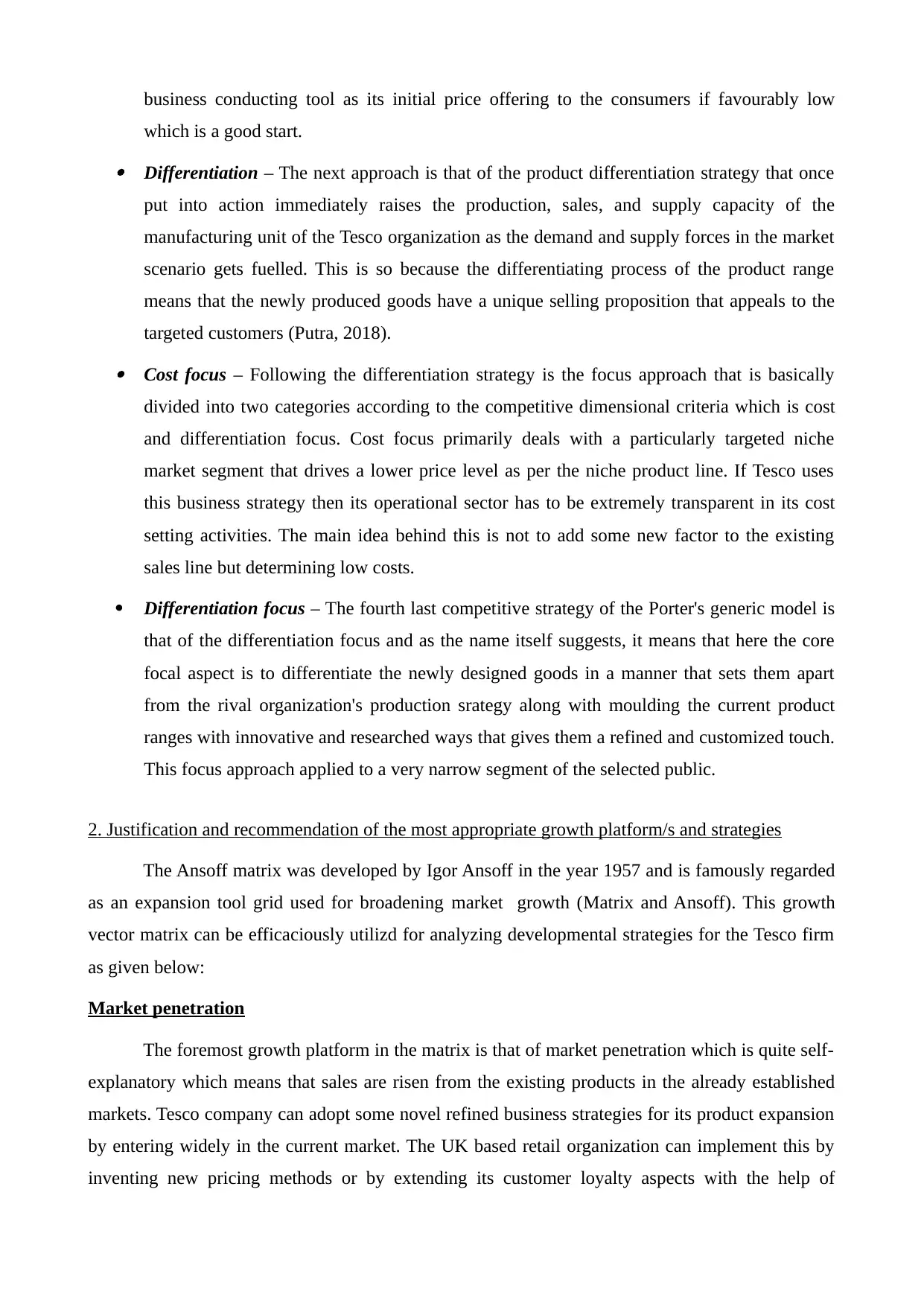
business conducting tool as its initial price offering to the consumers if favourably low
which is a good start.
Differentiation – The next approach is that of the product differentiation strategy that once
put into action immediately raises the production, sales, and supply capacity of the
manufacturing unit of the Tesco organization as the demand and supply forces in the market
scenario gets fuelled. This is so because the differentiating process of the product range
means that the newly produced goods have a unique selling proposition that appeals to the
targeted customers (Putra, 2018).
Cost focus – Following the differentiation strategy is the focus approach that is basically
divided into two categories according to the competitive dimensional criteria which is cost
and differentiation focus. Cost focus primarily deals with a particularly targeted niche
market segment that drives a lower price level as per the niche product line. If Tesco uses
this business strategy then its operational sector has to be extremely transparent in its cost
setting activities. The main idea behind this is not to add some new factor to the existing
sales line but determining low costs.
Differentiation focus – The fourth last competitive strategy of the Porter's generic model is
that of the differentiation focus and as the name itself suggests, it means that here the core
focal aspect is to differentiate the newly designed goods in a manner that sets them apart
from the rival organization's production srategy along with moulding the current product
ranges with innovative and researched ways that gives them a refined and customized touch.
This focus approach applied to a very narrow segment of the selected public.
2. Justification and recommendation of the most appropriate growth platform/s and strategies
The Ansoff matrix was developed by Igor Ansoff in the year 1957 and is famously regarded
as an expansion tool grid used for broadening market growth (Matrix and Ansoff). This growth
vector matrix can be efficaciously utilizd for analyzing developmental strategies for the Tesco firm
as given below:
Market penetration
The foremost growth platform in the matrix is that of market penetration which is quite self-
explanatory which means that sales are risen from the existing products in the already established
markets. Tesco company can adopt some novel refined business strategies for its product expansion
by entering widely in the current market. The UK based retail organization can implement this by
inventing new pricing methods or by extending its customer loyalty aspects with the help of
which is a good start.
Differentiation – The next approach is that of the product differentiation strategy that once
put into action immediately raises the production, sales, and supply capacity of the
manufacturing unit of the Tesco organization as the demand and supply forces in the market
scenario gets fuelled. This is so because the differentiating process of the product range
means that the newly produced goods have a unique selling proposition that appeals to the
targeted customers (Putra, 2018).
Cost focus – Following the differentiation strategy is the focus approach that is basically
divided into two categories according to the competitive dimensional criteria which is cost
and differentiation focus. Cost focus primarily deals with a particularly targeted niche
market segment that drives a lower price level as per the niche product line. If Tesco uses
this business strategy then its operational sector has to be extremely transparent in its cost
setting activities. The main idea behind this is not to add some new factor to the existing
sales line but determining low costs.
Differentiation focus – The fourth last competitive strategy of the Porter's generic model is
that of the differentiation focus and as the name itself suggests, it means that here the core
focal aspect is to differentiate the newly designed goods in a manner that sets them apart
from the rival organization's production srategy along with moulding the current product
ranges with innovative and researched ways that gives them a refined and customized touch.
This focus approach applied to a very narrow segment of the selected public.
2. Justification and recommendation of the most appropriate growth platform/s and strategies
The Ansoff matrix was developed by Igor Ansoff in the year 1957 and is famously regarded
as an expansion tool grid used for broadening market growth (Matrix and Ansoff). This growth
vector matrix can be efficaciously utilizd for analyzing developmental strategies for the Tesco firm
as given below:
Market penetration
The foremost growth platform in the matrix is that of market penetration which is quite self-
explanatory which means that sales are risen from the existing products in the already established
markets. Tesco company can adopt some novel refined business strategies for its product expansion
by entering widely in the current market. The UK based retail organization can implement this by
inventing new pricing methods or by extending its customer loyalty aspects with the help of
Secure Best Marks with AI Grader
Need help grading? Try our AI Grader for instant feedback on your assignments.
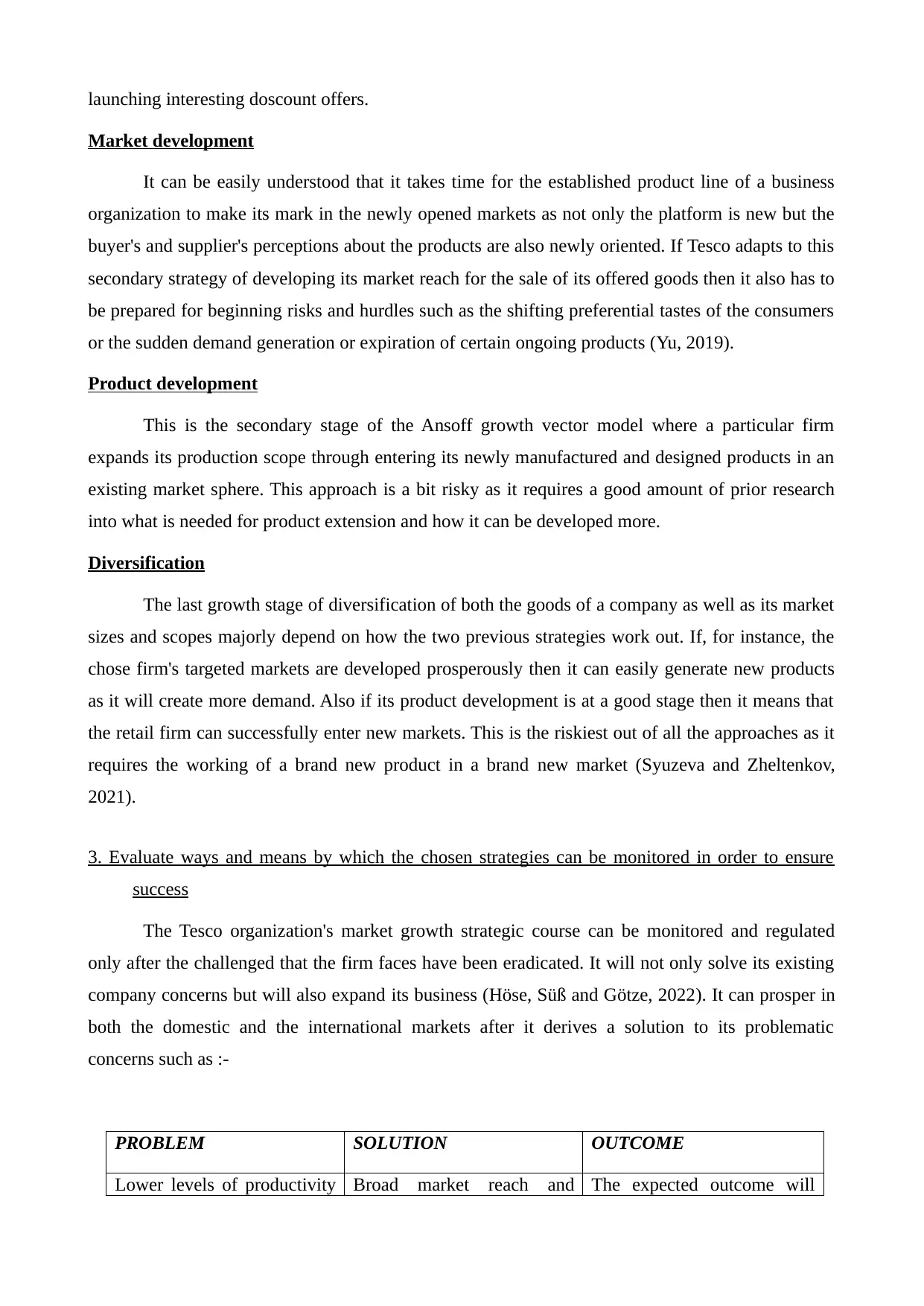
launching interesting doscount offers.
Market development
It can be easily understood that it takes time for the established product line of a business
organization to make its mark in the newly opened markets as not only the platform is new but the
buyer's and supplier's perceptions about the products are also newly oriented. If Tesco adapts to this
secondary strategy of developing its market reach for the sale of its offered goods then it also has to
be prepared for beginning risks and hurdles such as the shifting preferential tastes of the consumers
or the sudden demand generation or expiration of certain ongoing products (Yu, 2019).
Product development
This is the secondary stage of the Ansoff growth vector model where a particular firm
expands its production scope through entering its newly manufactured and designed products in an
existing market sphere. This approach is a bit risky as it requires a good amount of prior research
into what is needed for product extension and how it can be developed more.
Diversification
The last growth stage of diversification of both the goods of a company as well as its market
sizes and scopes majorly depend on how the two previous strategies work out. If, for instance, the
chose firm's targeted markets are developed prosperously then it can easily generate new products
as it will create more demand. Also if its product development is at a good stage then it means that
the retail firm can successfully enter new markets. This is the riskiest out of all the approaches as it
requires the working of a brand new product in a brand new market (Syuzeva and Zheltenkov,
2021).
3. Evaluate ways and means by which the chosen strategies can be monitored in order to ensure
success
The Tesco organization's market growth strategic course can be monitored and regulated
only after the challenged that the firm faces have been eradicated. It will not only solve its existing
company concerns but will also expand its business (Höse, Süß and Götze, 2022). It can prosper in
both the domestic and the international markets after it derives a solution to its problematic
concerns such as :-
PROBLEM SOLUTION OUTCOME
Lower levels of productivity Broad market reach and The expected outcome will
Market development
It can be easily understood that it takes time for the established product line of a business
organization to make its mark in the newly opened markets as not only the platform is new but the
buyer's and supplier's perceptions about the products are also newly oriented. If Tesco adapts to this
secondary strategy of developing its market reach for the sale of its offered goods then it also has to
be prepared for beginning risks and hurdles such as the shifting preferential tastes of the consumers
or the sudden demand generation or expiration of certain ongoing products (Yu, 2019).
Product development
This is the secondary stage of the Ansoff growth vector model where a particular firm
expands its production scope through entering its newly manufactured and designed products in an
existing market sphere. This approach is a bit risky as it requires a good amount of prior research
into what is needed for product extension and how it can be developed more.
Diversification
The last growth stage of diversification of both the goods of a company as well as its market
sizes and scopes majorly depend on how the two previous strategies work out. If, for instance, the
chose firm's targeted markets are developed prosperously then it can easily generate new products
as it will create more demand. Also if its product development is at a good stage then it means that
the retail firm can successfully enter new markets. This is the riskiest out of all the approaches as it
requires the working of a brand new product in a brand new market (Syuzeva and Zheltenkov,
2021).
3. Evaluate ways and means by which the chosen strategies can be monitored in order to ensure
success
The Tesco organization's market growth strategic course can be monitored and regulated
only after the challenged that the firm faces have been eradicated. It will not only solve its existing
company concerns but will also expand its business (Höse, Süß and Götze, 2022). It can prosper in
both the domestic and the international markets after it derives a solution to its problematic
concerns such as :-
PROBLEM SOLUTION OUTCOME
Lower levels of productivity Broad market reach and The expected outcome will
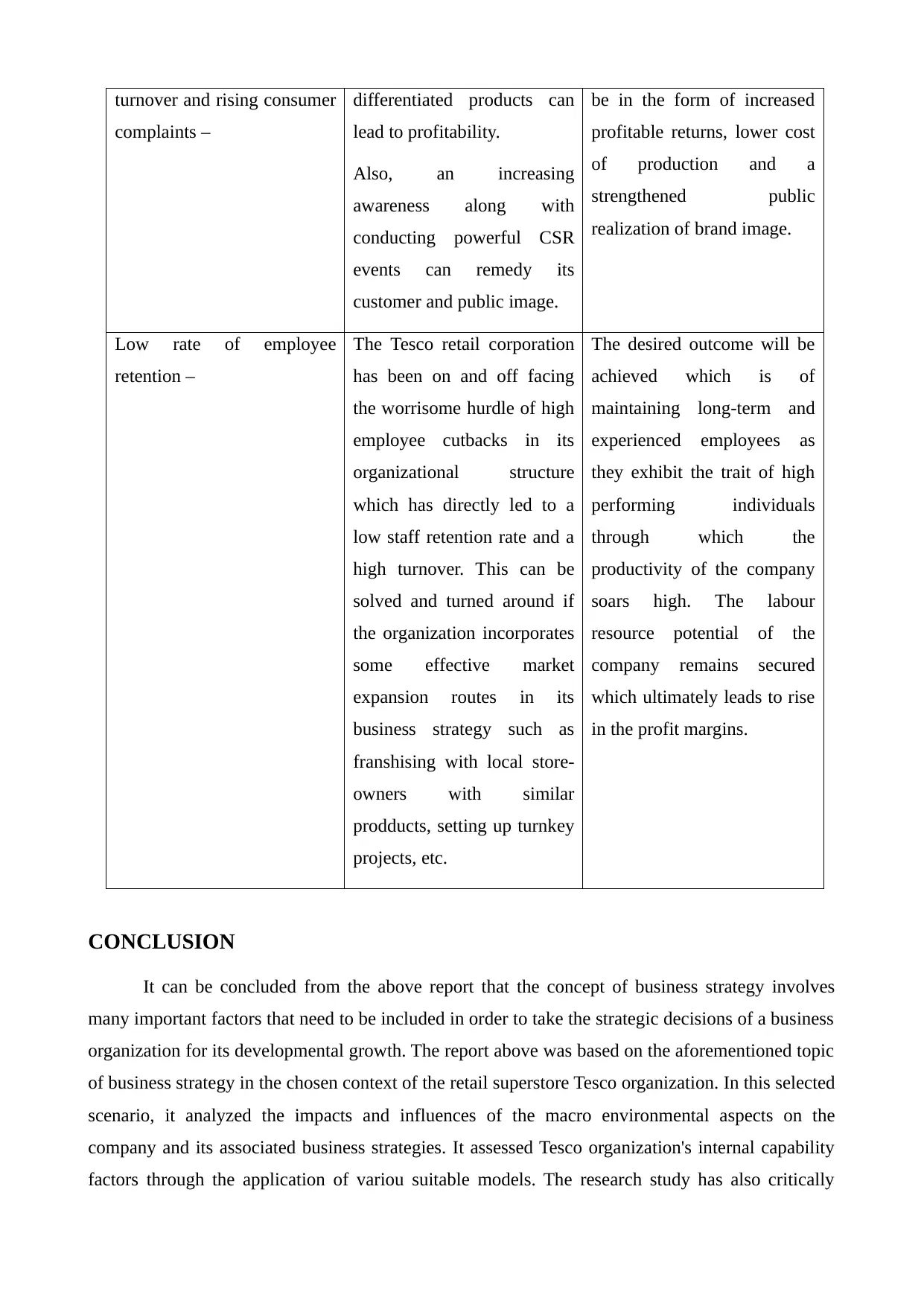
turnover and rising consumer
complaints –
differentiated products can
lead to profitability.
Also, an increasing
awareness along with
conducting powerful CSR
events can remedy its
customer and public image.
be in the form of increased
profitable returns, lower cost
of production and a
strengthened public
realization of brand image.
Low rate of employee
retention –
The Tesco retail corporation
has been on and off facing
the worrisome hurdle of high
employee cutbacks in its
organizational structure
which has directly led to a
low staff retention rate and a
high turnover. This can be
solved and turned around if
the organization incorporates
some effective market
expansion routes in its
business strategy such as
franshising with local store-
owners with similar
prodducts, setting up turnkey
projects, etc.
The desired outcome will be
achieved which is of
maintaining long-term and
experienced employees as
they exhibit the trait of high
performing individuals
through which the
productivity of the company
soars high. The labour
resource potential of the
company remains secured
which ultimately leads to rise
in the profit margins.
CONCLUSION
It can be concluded from the above report that the concept of business strategy involves
many important factors that need to be included in order to take the strategic decisions of a business
organization for its developmental growth. The report above was based on the aforementioned topic
of business strategy in the chosen context of the retail superstore Tesco organization. In this selected
scenario, it analyzed the impacts and influences of the macro environmental aspects on the
company and its associated business strategies. It assessed Tesco organization's internal capability
factors through the application of variou suitable models. The research study has also critically
complaints –
differentiated products can
lead to profitability.
Also, an increasing
awareness along with
conducting powerful CSR
events can remedy its
customer and public image.
be in the form of increased
profitable returns, lower cost
of production and a
strengthened public
realization of brand image.
Low rate of employee
retention –
The Tesco retail corporation
has been on and off facing
the worrisome hurdle of high
employee cutbacks in its
organizational structure
which has directly led to a
low staff retention rate and a
high turnover. This can be
solved and turned around if
the organization incorporates
some effective market
expansion routes in its
business strategy such as
franshising with local store-
owners with similar
prodducts, setting up turnkey
projects, etc.
The desired outcome will be
achieved which is of
maintaining long-term and
experienced employees as
they exhibit the trait of high
performing individuals
through which the
productivity of the company
soars high. The labour
resource potential of the
company remains secured
which ultimately leads to rise
in the profit margins.
CONCLUSION
It can be concluded from the above report that the concept of business strategy involves
many important factors that need to be included in order to take the strategic decisions of a business
organization for its developmental growth. The report above was based on the aforementioned topic
of business strategy in the chosen context of the retail superstore Tesco organization. In this selected
scenario, it analyzed the impacts and influences of the macro environmental aspects on the
company and its associated business strategies. It assessed Tesco organization's internal capability
factors through the application of variou suitable models. The research study has also critically
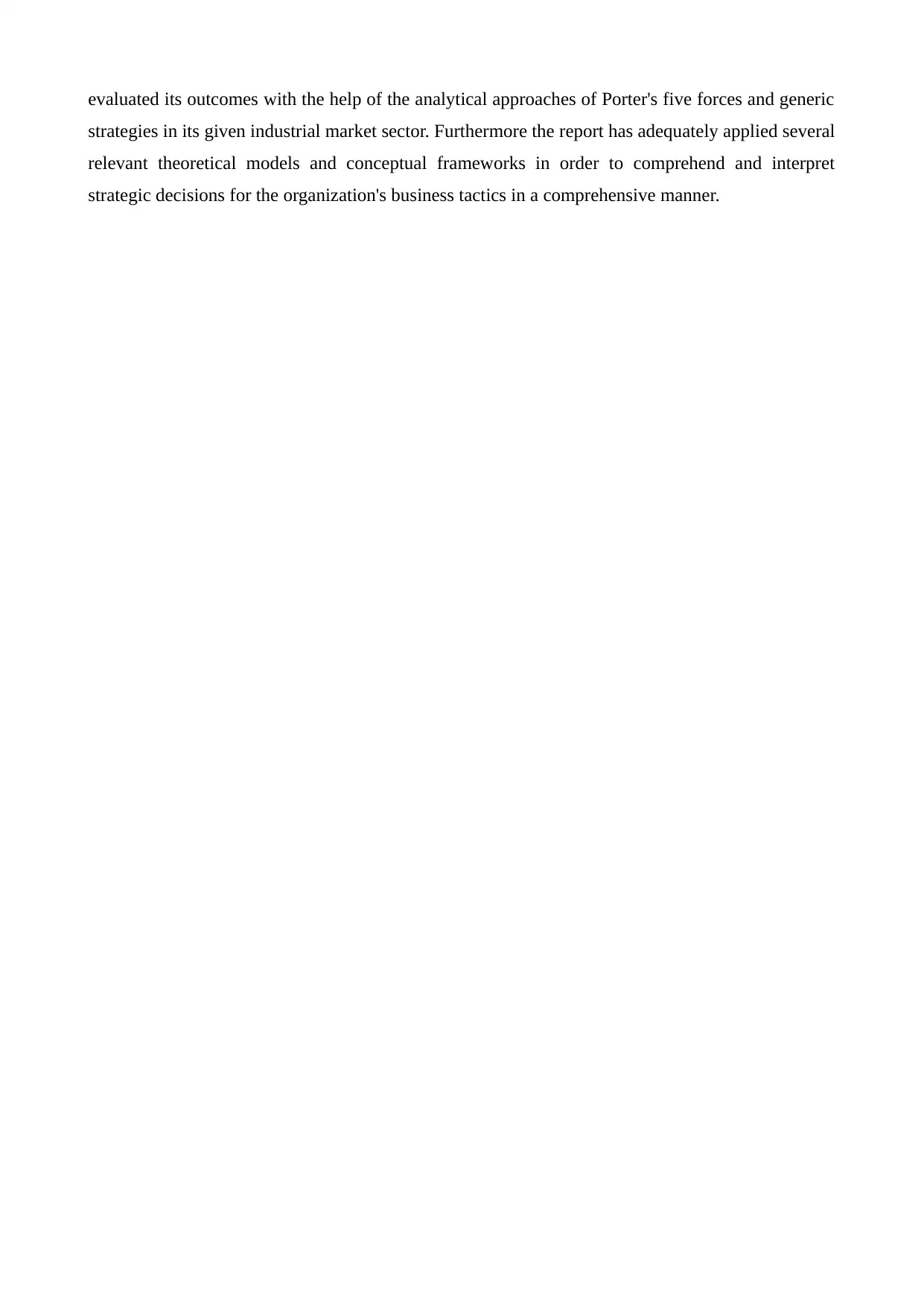
evaluated its outcomes with the help of the analytical approaches of Porter's five forces and generic
strategies in its given industrial market sector. Furthermore the report has adequately applied several
relevant theoretical models and conceptual frameworks in order to comprehend and interpret
strategic decisions for the organization's business tactics in a comprehensive manner.
strategies in its given industrial market sector. Furthermore the report has adequately applied several
relevant theoretical models and conceptual frameworks in order to comprehend and interpret
strategic decisions for the organization's business tactics in a comprehensive manner.
Paraphrase This Document
Need a fresh take? Get an instant paraphrase of this document with our AI Paraphraser
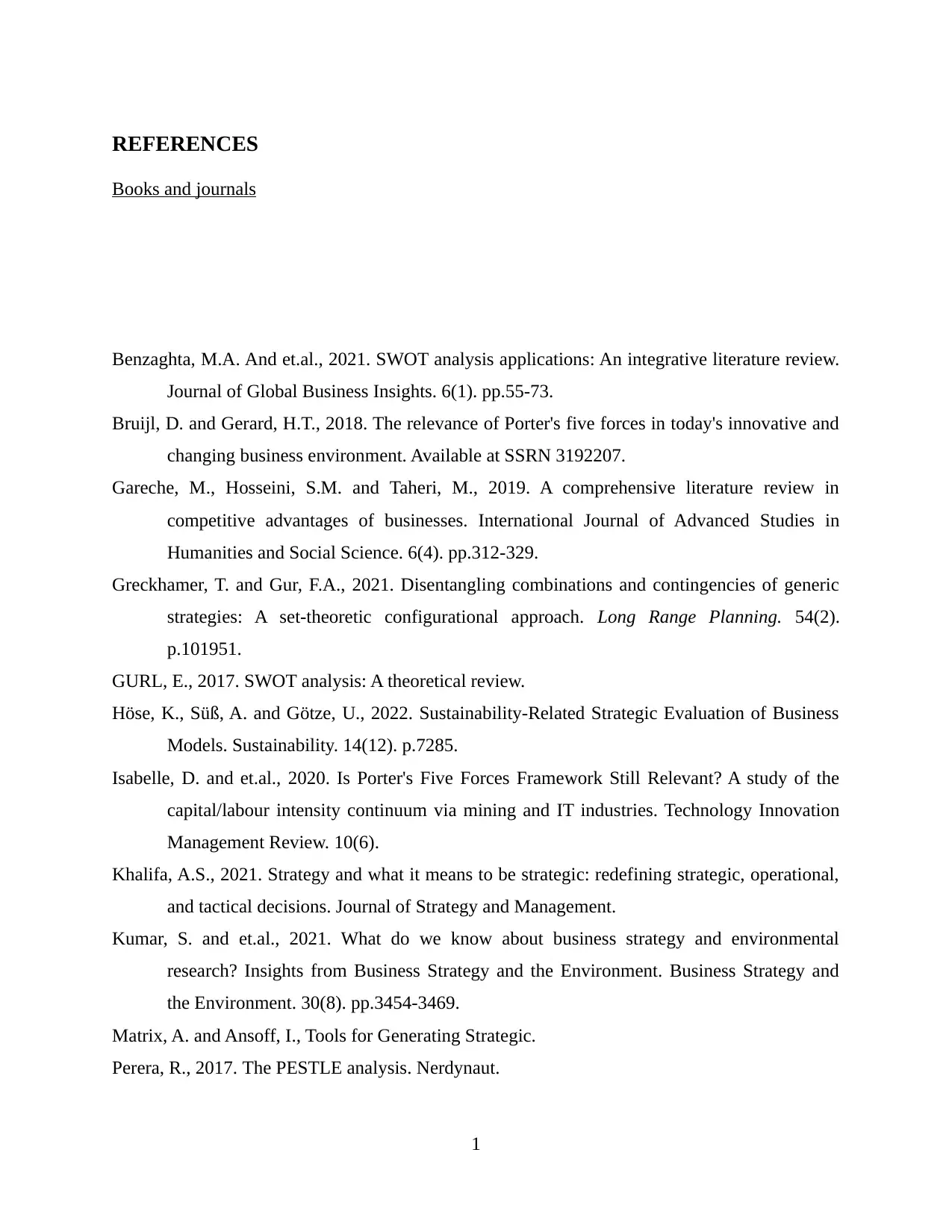
REFERENCES
Books and journals
Benzaghta, M.A. And et.al., 2021. SWOT analysis applications: An integrative literature review.
Journal of Global Business Insights. 6(1). pp.55-73.
Bruijl, D. and Gerard, H.T., 2018. The relevance of Porter's five forces in today's innovative and
changing business environment. Available at SSRN 3192207.
Gareche, M., Hosseini, S.M. and Taheri, M., 2019. A comprehensive literature review in
competitive advantages of businesses. International Journal of Advanced Studies in
Humanities and Social Science. 6(4). pp.312-329.
Greckhamer, T. and Gur, F.A., 2021. Disentangling combinations and contingencies of generic
strategies: A set-theoretic configurational approach. Long Range Planning. 54(2).
p.101951.
GURL, E., 2017. SWOT analysis: A theoretical review.
Höse, K., Süß, A. and Götze, U., 2022. Sustainability-Related Strategic Evaluation of Business
Models. Sustainability. 14(12). p.7285.
Isabelle, D. and et.al., 2020. Is Porter's Five Forces Framework Still Relevant? A study of the
capital/labour intensity continuum via mining and IT industries. Technology Innovation
Management Review. 10(6).
Khalifa, A.S., 2021. Strategy and what it means to be strategic: redefining strategic, operational,
and tactical decisions. Journal of Strategy and Management.
Kumar, S. and et.al., 2021. What do we know about business strategy and environmental
research? Insights from Business Strategy and the Environment. Business Strategy and
the Environment. 30(8). pp.3454-3469.
Matrix, A. and Ansoff, I., Tools for Generating Strategic.
Perera, R., 2017. The PESTLE analysis. Nerdynaut.
1
Books and journals
Benzaghta, M.A. And et.al., 2021. SWOT analysis applications: An integrative literature review.
Journal of Global Business Insights. 6(1). pp.55-73.
Bruijl, D. and Gerard, H.T., 2018. The relevance of Porter's five forces in today's innovative and
changing business environment. Available at SSRN 3192207.
Gareche, M., Hosseini, S.M. and Taheri, M., 2019. A comprehensive literature review in
competitive advantages of businesses. International Journal of Advanced Studies in
Humanities and Social Science. 6(4). pp.312-329.
Greckhamer, T. and Gur, F.A., 2021. Disentangling combinations and contingencies of generic
strategies: A set-theoretic configurational approach. Long Range Planning. 54(2).
p.101951.
GURL, E., 2017. SWOT analysis: A theoretical review.
Höse, K., Süß, A. and Götze, U., 2022. Sustainability-Related Strategic Evaluation of Business
Models. Sustainability. 14(12). p.7285.
Isabelle, D. and et.al., 2020. Is Porter's Five Forces Framework Still Relevant? A study of the
capital/labour intensity continuum via mining and IT industries. Technology Innovation
Management Review. 10(6).
Khalifa, A.S., 2021. Strategy and what it means to be strategic: redefining strategic, operational,
and tactical decisions. Journal of Strategy and Management.
Kumar, S. and et.al., 2021. What do we know about business strategy and environmental
research? Insights from Business Strategy and the Environment. Business Strategy and
the Environment. 30(8). pp.3454-3469.
Matrix, A. and Ansoff, I., Tools for Generating Strategic.
Perera, R., 2017. The PESTLE analysis. Nerdynaut.
1
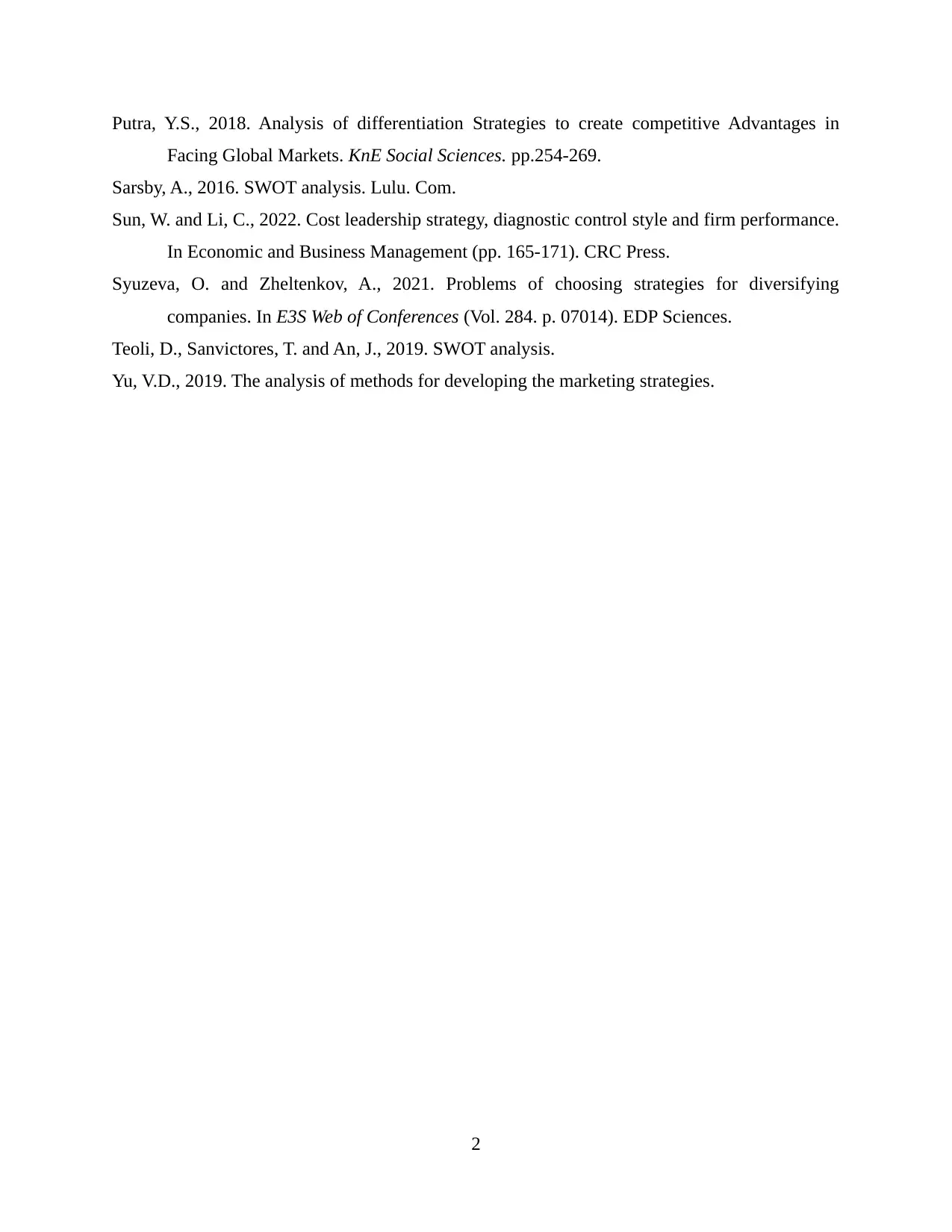
Putra, Y.S., 2018. Analysis of differentiation Strategies to create competitive Advantages in
Facing Global Markets. KnE Social Sciences. pp.254-269.
Sarsby, A., 2016. SWOT analysis. Lulu. Com.
Sun, W. and Li, C., 2022. Cost leadership strategy, diagnostic control style and firm performance.
In Economic and Business Management (pp. 165-171). CRC Press.
Syuzeva, O. and Zheltenkov, A., 2021. Problems of choosing strategies for diversifying
companies. In E3S Web of Conferences (Vol. 284. p. 07014). EDP Sciences.
Teoli, D., Sanvictores, T. and An, J., 2019. SWOT analysis.
Yu, V.D., 2019. The analysis of methods for developing the marketing strategies.
2
Facing Global Markets. KnE Social Sciences. pp.254-269.
Sarsby, A., 2016. SWOT analysis. Lulu. Com.
Sun, W. and Li, C., 2022. Cost leadership strategy, diagnostic control style and firm performance.
In Economic and Business Management (pp. 165-171). CRC Press.
Syuzeva, O. and Zheltenkov, A., 2021. Problems of choosing strategies for diversifying
companies. In E3S Web of Conferences (Vol. 284. p. 07014). EDP Sciences.
Teoli, D., Sanvictores, T. and An, J., 2019. SWOT analysis.
Yu, V.D., 2019. The analysis of methods for developing the marketing strategies.
2
1 out of 15
Related Documents
Your All-in-One AI-Powered Toolkit for Academic Success.
+13062052269
info@desklib.com
Available 24*7 on WhatsApp / Email
![[object Object]](/_next/static/media/star-bottom.7253800d.svg)
Unlock your academic potential
© 2024 | Zucol Services PVT LTD | All rights reserved.


